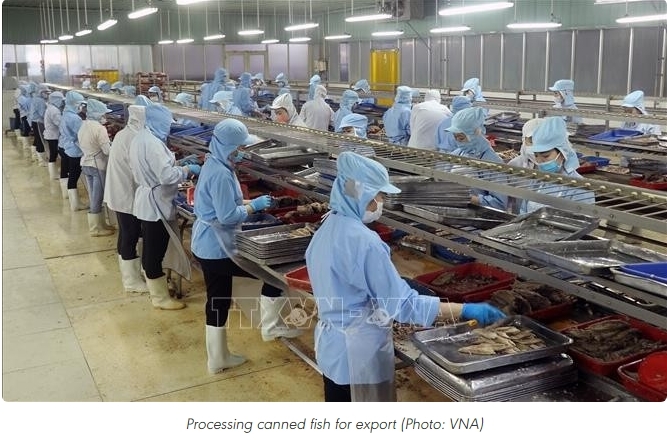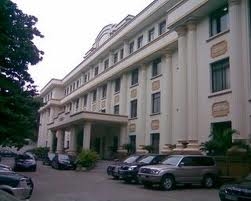US cuts tariff to 20% on Vietnam, investment unaffected: expert
Tuesday, August 5,2025
AsemconnectVietnam - An expert from the University of Economics and Business called the 20% rate “relatively appropriate”, given Vietnam’s considerable trade surplus with the US.
The US's new 20% reciprocal tariff on Vietnamese imports, down from 46%, will not derail investment flows into Vietnam, according to Dr. Le Quang Minh from the University of Economics and Business at the Vietnam National University-Hanoi.
The reduction, a positive result of bilateral negotiations, reflects Vietnam’s growing stature as the US’s key trade partner in Southeast Asia, Minh told the Vietnam News Agency.
The tariff, effective on August 7, 2025, as outlined in an executive order signed by President Donald J. Trump, is notably lower than those imposed on other major exporters, including India (25%), Canada (35%), and China (50%). Minh called the 20% rate “relatively appropriate”, given Vietnam’s considerable trade surplus with the US.
This is both a challenge and a driving force for Vietnam to deepen reforms and bolster competitiveness, he said, stressing that the tariff cut reflects Vietnam’s importance in the global supply chain.
Meanwhile, the "not too big" tariff difference from neighbouring countries' such as Thailand, Cambodia, Indonesia, Malaysia, and the Philippines, all at 19%, may slightly dent Vietnamese goods' competitiveness against these rivals, but is unlikely to cause considerable impact on investment flows, he opined.
To secure further reductions, possibly for specific industries, Vietnamese ministries and agencies should persist in dialogue with US counterparts to foster a fair and mutually beneficial trade environment, he advised.
He stressed the need for greater market transparency, particularly in product origin rules to address US concerns about trade fraud and illegal transshipment. Providing businesses with guidance and support to boost competitiveness and diversify export markets is also critical, he added.
Vietnamese companies, he urged, must invest in research and development, increase local content in products, and build independent brands to boost value and shed their role as a low-cost manufacturing hub. They should also negotiate with US importers to share tariff burdens, streamline production costs, and tap new export destinations to reduce reliance on a single market./.
The US's new 20% reciprocal tariff on Vietnamese imports, down from 46%, will not derail investment flows into Vietnam, according to Dr. Le Quang Minh from the University of Economics and Business at the Vietnam National University-Hanoi.
The reduction, a positive result of bilateral negotiations, reflects Vietnam’s growing stature as the US’s key trade partner in Southeast Asia, Minh told the Vietnam News Agency.
The tariff, effective on August 7, 2025, as outlined in an executive order signed by President Donald J. Trump, is notably lower than those imposed on other major exporters, including India (25%), Canada (35%), and China (50%). Minh called the 20% rate “relatively appropriate”, given Vietnam’s considerable trade surplus with the US.
This is both a challenge and a driving force for Vietnam to deepen reforms and bolster competitiveness, he said, stressing that the tariff cut reflects Vietnam’s importance in the global supply chain.
Meanwhile, the "not too big" tariff difference from neighbouring countries' such as Thailand, Cambodia, Indonesia, Malaysia, and the Philippines, all at 19%, may slightly dent Vietnamese goods' competitiveness against these rivals, but is unlikely to cause considerable impact on investment flows, he opined.
To secure further reductions, possibly for specific industries, Vietnamese ministries and agencies should persist in dialogue with US counterparts to foster a fair and mutually beneficial trade environment, he advised.
He stressed the need for greater market transparency, particularly in product origin rules to address US concerns about trade fraud and illegal transshipment. Providing businesses with guidance and support to boost competitiveness and diversify export markets is also critical, he added.
Vietnamese companies, he urged, must invest in research and development, increase local content in products, and build independent brands to boost value and shed their role as a low-cost manufacturing hub. They should also negotiate with US importers to share tariff burdens, streamline production costs, and tap new export destinations to reduce reliance on a single market./.
Source: en.vietnamplus.vn/us-cuts-tariff-to-20-on-vietnam-investment-unaffected-expert-post323958.vnp
The reduction, a positive result of bilateral negotiations, reflects Vietnam’s growing stature as the US’s key trade partner in Southeast Asia, Minh told the Vietnam News Agency.
The tariff, effective on August 7, 2025, as outlined in an executive order signed by President Donald J. Trump, is notably lower than those imposed on other major exporters, including India (25%), Canada (35%), and China (50%). Minh called the 20% rate “relatively appropriate”, given Vietnam’s considerable trade surplus with the US.
This is both a challenge and a driving force for Vietnam to deepen reforms and bolster competitiveness, he said, stressing that the tariff cut reflects Vietnam’s importance in the global supply chain.
Meanwhile, the "not too big" tariff difference from neighbouring countries' such as Thailand, Cambodia, Indonesia, Malaysia, and the Philippines, all at 19%, may slightly dent Vietnamese goods' competitiveness against these rivals, but is unlikely to cause considerable impact on investment flows, he opined.
To secure further reductions, possibly for specific industries, Vietnamese ministries and agencies should persist in dialogue with US counterparts to foster a fair and mutually beneficial trade environment, he advised.
He stressed the need for greater market transparency, particularly in product origin rules to address US concerns about trade fraud and illegal transshipment. Providing businesses with guidance and support to boost competitiveness and diversify export markets is also critical, he added.
Vietnamese companies, he urged, must invest in research and development, increase local content in products, and build independent brands to boost value and shed their role as a low-cost manufacturing hub. They should also negotiate with US importers to share tariff burdens, streamline production costs, and tap new export destinations to reduce reliance on a single market./.
The US's new 20% reciprocal tariff on Vietnamese imports, down from 46%, will not derail investment flows into Vietnam, according to Dr. Le Quang Minh from the University of Economics and Business at the Vietnam National University-Hanoi.
The reduction, a positive result of bilateral negotiations, reflects Vietnam’s growing stature as the US’s key trade partner in Southeast Asia, Minh told the Vietnam News Agency.
The tariff, effective on August 7, 2025, as outlined in an executive order signed by President Donald J. Trump, is notably lower than those imposed on other major exporters, including India (25%), Canada (35%), and China (50%). Minh called the 20% rate “relatively appropriate”, given Vietnam’s considerable trade surplus with the US.
This is both a challenge and a driving force for Vietnam to deepen reforms and bolster competitiveness, he said, stressing that the tariff cut reflects Vietnam’s importance in the global supply chain.
Meanwhile, the "not too big" tariff difference from neighbouring countries' such as Thailand, Cambodia, Indonesia, Malaysia, and the Philippines, all at 19%, may slightly dent Vietnamese goods' competitiveness against these rivals, but is unlikely to cause considerable impact on investment flows, he opined.
To secure further reductions, possibly for specific industries, Vietnamese ministries and agencies should persist in dialogue with US counterparts to foster a fair and mutually beneficial trade environment, he advised.
He stressed the need for greater market transparency, particularly in product origin rules to address US concerns about trade fraud and illegal transshipment. Providing businesses with guidance and support to boost competitiveness and diversify export markets is also critical, he added.
Vietnamese companies, he urged, must invest in research and development, increase local content in products, and build independent brands to boost value and shed their role as a low-cost manufacturing hub. They should also negotiate with US importers to share tariff burdens, streamline production costs, and tap new export destinations to reduce reliance on a single market./.
Source: en.vietnamplus.vn/us-cuts-tariff-to-20-on-vietnam-investment-unaffected-expert-post323958.vnp
EVFTA fuels growth but demands more to unlock full potential: Ambassador
Free trade zones hoped to give boost to economic growth
EVFTA – a launchpad for Vietnam-Italy trade to soar
EVFTA after 5 years: Trade Counselor highlights gains, challenges, strategic path forward
Vietnam, Tanzania explore local cooperation opportunities
Swiss-Viet Economic Forum places strong expectations on top Vietnamese legislator’s trip
Germany pushes ratification of EU - Vietnam Investment Protection Agreement
Mega Us Expo 2025 to boost Vietnam–RoK trade, innovation cooperation
Vietnamese lychees on shelves of US retail giant Costco
US promotes agricultural products to Vietnamese consumers
Vietnam highlighted as next growth engine in ASEAN at Hong Kong seminar
Vietnam fosters comprehensive cooperation with France's Normandy region
Hai Phong exhibition at ABAC 3 highlights local economy, specialties
Conference seeks ways to promote Vietnam – Cambodia trade

Plan of Hai Duong province for a period of 2021 - 2030, ...
Organize space reasonably and harmoniously, focusing on connecting Hai Duong in common development space, actively contributing to the ...Plan of Hau Giang province in a period of 2021 - 2030, ...
Sustainable forestry development program in a period of ...

AI opens new path for image industry: Insiders
Though the term "image industry" remains relatively new in the local context, the development of a creative ecosystem driven by AI will ...Hanoi’s street food culture gains ground with Michelin nods
Draw held for 2025 Davis Cup Asia/Oceania Group III in Bac ...
Da Nang Museum opens an exhibition of rare ancient ...
An Giang races to complete UNESCO nomination dossier for ...



